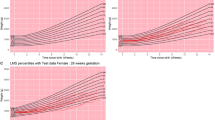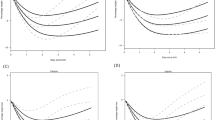Abstract
Objectives:
We sought to generate a contemporary postnatal weight grid for low birth weight (LBW, <2500 g) neonates using actual data, not mathematically derived idealized weight curves. To do this, we collected electronic data from all neonatal intensive care units (NICU) patients weighing 400–2600 g at birth, during 30 consecutive months (January 2003–June 2005) in all four NICU's within a single health system, Intermountain Health Care (IHC).
Methods:
A deidentified limited data set was collected from electronic IHC records. Data were limited to the birth weights and all subsequent daily weights, until discharge, death, or transfer to a non-IHC facility. Lines were drawn connecting the exact daily means of body weight for patients in 200 g birth weight groupings, ranging from 400 to 2600 g. We assessed differences in growth patterns predicted by this grid vs three previously published NICU longitudinal weight grids.
Results:
All recorded weights were electronically extracted for 1813 consecutive patients with dates of birth from January 1, 2003 through June 30, 2005. The daily weights of each patient totaled over 48 000 individual data points. The new grid differed from previously published grids, in that the new grid showed; (1) no predicted postnatal weight loss among neonates in categories <900 g birth weight, (2) less initial weight loss among neonates 900–2500 g, (3) fewer days to regain birth weight among neonates ⩽2000 g, and (4) fewer days to gain 100 and 300 g above birth weight in neonates ⩽1500 g.
Speculation:
For charting serial weights of LBW neonates in the NICU the new grid may be a useful standard.
This is a preview of subscription content, access via your institution
Access options
Subscribe to this journal
Receive 12 print issues and online access
$259.00 per year
only $21.58 per issue
Buy this article
- Purchase on Springer Link
- Instant access to full article PDF
Prices may be subject to local taxes which are calculated during checkout



Similar content being viewed by others
References
Dancis J, O'Connell JR, Holt Jr LE . A grid for recording the weight of premature infants. J Pediatr 1948; 33: 570–572.
Shaffer SG, Quimiro CL, Anderson JV, Hall RT . Postnatal weight changes in low birth weight infants. Pediatrics 1987; 79: 702–705.
Wright K, Dawson JP, Fallis D . New postnatal growth grids for very low birth weight infants. Pediatrics 1993; 91: 922–926.
Lair CS, Kennedy KA . Monitoring postnatal growth in the neonatal intensive care unit. Nutr Clin Pract 1997; 12: 124–129.
Ehrenkranz RA, Younes N, Lemons JA, Fanaroff AA, Donovan EF, Wright LL et al. Longitudinal growth of hospitalized very low birth weight infants. Pediatrics 1999; 104: 280–289.
Adamkin DH . Pragmatic approach to in-hospital nutrition in high-risk neonates. J Perinatol 2005; 25 (Suppl 2): S7–S11.
Thureen PJ, Hay Jr WW . Early aggressive nutrition in preterm infants. Semin Neonatol 2001; 6: 403–415.
Thureen PJ, Melara D, Fennessey PV, Hay Jr WW . Effect of low versus high intravenous amino acid intake on very low birth weight infants in the early neonatal period. Pediatr Res 2003; 53: 24–32.
Ridout E, Melara D, Rottinghaus S, Thureen PJ . Blood urea nitrogen concentration as a marker of amino-acid intolerance in neonates with birthweight less than 1250 g. J Perinatol 2005; 25: 130–133.
Ibrahim HM, Jeroudi MA, Baier RJ, Dhanireddy R, Krouskop RW . Aggressive early total parental nutrition in low-birth-weight infants. J Perinatol 2004; 24: 482–486.
Reis BB . Enhanced growth of preterm infants fed new powdered human milk fortifier: randomized, controlled trial. Pediatrics 2000; 106: 581–588.
Clandinin MT . Growth and development of preterm infants fed infant formulas containing docosahexaenoic acid and arachidonic acid. J Pediatr 2005; 146: 461–468.
Christensen RD, Street J . Randomized, controlled trial of slow versus rapid feeding volume advancement in preterm infants (Commentary). J Pediatr 2005; 146: 710–711.
Caple J, Armentrout D, Huseby V, Halbardier B, Garcia J, Sparks JW . Randomized, controlled trial of slow versus rapid feeding volume advancement in preterm infants. Pediatrics 2004; 114: 1597–1600.
Berseth CL . Feeding methods for the preterm infant. Semin Neonatol 2001; 6: 417–424.
Kuzma-O'Reilly B, Duenas ML, Greecher C, Kimberlin L, Mujsce D, Miller D et al. Evaluation, development, and implementation of potentially better practices in neonatal intensive care nutrition. Pediatrics 2003; 111: e461–e470.
Premji SS, Paes B, Jacobson K, Chessell L . Evidence-based feeding guidelines for very low-birth-weight infants. Neonatal Care 2002; 2: 5–18.
Schanler RJ . The use of human milk for premature infants. Pediatr Clin North Am 2001; 48: 207–219.
Lawn CJ, Weir FJ, McGuire W . Base administration or fluid bolus for preventing morbidity and mortality in preterm infants with metabolic acidosis. Cochrane Database Syst Rev 2005; 18: CD003215.
Modi N . Management of fluid balance in the very immature neonate. Arch Dis Child Fetal Neonatal Ed 2004; 89: F108–F111.
Taylor HG, Minich N, Bangert B, Filipek PA, Hack M . Long-term neuropsy-chological outcomes of very low birth weight: associations with early risks for periventricular brain insults. J Int Neuropsychol Soc 2004; 10: 987–1004.
Hack M, Wilson-Costello D, Friedman H, Taylor GH, Schluchter M, Fanaroff AA . Neurodevelopment and predictors of outcomes of children with birth weights of less than 1000 g: 1992–1995. Arch Pediatr Adolesc Med 2000; 154: 725–731.
Cooke RJ . Postnatal growth in preterm infants: have we got it right? J Perinatol 2005; 25 (Suppl 2): S12–S14.
Cooke RJ, Ainsworth SB, Fenton AC . Postnatal growth retardation: a universal problem in preterm infants. Arch Dis Child Fetal Neonatal Ed 2004; 89: F428–F430.
Clark RH, Thomas P, Peabody J . Extrauterine growth restriction remains a serious problem in prematurely born neonates. Pediatrics 2003; 111: 986–990.
Clark RH . Nutrition in the neonatal intensive care unit: how do we reduce the incidence of extrauterine growth restriction? J Perinatol 2003; 23: 337–344.
Acknowledgements
We thank the staff nurses at McKay-Dee Hospital, Ogden, UT, LDS Hospital, Salt Lake City, UT, Primary Children's Medical Center, Salt Lake City, UT, and Utah Valley Regional Medical Center, Provo, UT for making and recording all the daily weights on which this study is based.
Author information
Authors and Affiliations
Corresponding author
Rights and permissions
About this article
Cite this article
Christensen, R., Henry, E., Kiehn, T. et al. Pattern of daily weights among low birth weight neonates in the neonatal intensive care unit: data from a multihospital health-care system. J Perinatol 26, 37–43 (2006). https://doi.org/10.1038/sj.jp.7211431
Received:
Revised:
Accepted:
Published:
Issue Date:
DOI: https://doi.org/10.1038/sj.jp.7211431
Keywords
This article is cited by
-
Fluid handling and blood flow patterns in neonatal respiratory distress syndrome versus transient tachypnea: a pilot study
BMC Pediatrics (2021)
-
Modelling predictive gender- and gestation-specific weight reference centiles for preterm infants using a population-based cohort study
Scientific Reports (2020)
-
A systematic review and meta-analysis to revise the Fenton growth chart for preterm infants
BMC Pediatrics (2013)



